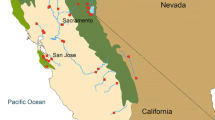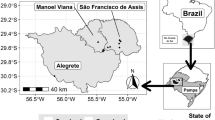Abstract
Land-use changes and land cover change are drivers of diversity. The effects of such drivers over the temporal trend in species richness and composition, particularly on invertebrate diversity in megadiverse countries, is controversial. One key animal group to clarify this controversy is that of odonate insects (dragonflies and damselflies), given their combined close water-land requirements. We have investigated whether changes in land use impact species richness and composition of odonates from 1980 to 1993 (period I) to 1994–2010 (period II) in Mexico. The effect of land use changes and land cover changes on species richness was analyzed using multiple diversity measures and at different spatial scales. In period II, an area reduction in original vegetation and increase in land use occurred. Responses to land use varied among spatial scales and measures of diversity but, overall, species richness in the transformed area was higher than in the original vegetation. However, species composition indicated a high species turnover inside hydrologic regions (watersheds) and across land uses classes, particularly between original and secondary vegetation. Our interpretation is that despite high land use conversion in Mexico, adult odonates seem resilient to land use change in terms of species richness, but not in species composition, which is in partial agreement with the intermediate disturbance hypothesis. Finally, we suggest that hydrologic region scale and use of entropy maximization (HCDT entropy), could provide a reliable biodiversity estimation of species loss associated with land use change.



Similar content being viewed by others
References
Abbot JC, Broglie D (2005) OdonataCentral.com: a Model for the Web-based Delivery of Natural History Information and Citizen Science. Am Entomol 51:240–243
Allan E, Manning P, Alt F et al (2015) Land use intensification alters ecosystem multifunctionality via loss of biodiversity and changes to functional composition. Ecol Lett 18:834–843. https://doi.org/10.1111/ele.12469
Ball-Damerow JE, M’Gonigle LK, Resh VH (2014) Local and regional factors influencing assemblages of dragonflies and damselflies (Odonata) in California and Nevada. J Insect Conserv. https://doi.org/10.1007/s10841-014-9709-6
Beck J, Kitching I (2007) Estimating regional species richness of tropical insects from museum data: a comparison of a geography-based and sample-based methods. J Appl Ecol 44:672–681. https://doi.org/10.1111/j.1365-2664.2007.01291.x
Bried JT, Mazzacano CA (2010) National review of state wildlife action plans for Odonata species of greatest conservation need. Insect Conserv Divers 3:61–71. https://doi.org/10.1111/j.1752-4598.2010.00081.x
Bried JT, Hassall C, Simaika JP et al (2015) Directions in applied odonatology: preface to the special series. Freshw Sci 34:1020–1022. https://doi.org/10.1086/682393
Cardinale BJ, Gonzalez A, Allington GRH, Loreau M (2018) Is local biodiversity declining or not? A summary of the debate over analysis of species richness time trends. Biol Conserv 219:175–183. https://doi.org/10.1016/j.biocon.2017.12.021
Carvalho JC, Cardoso P, Borges PAV et al (2013) Measuring fractions of beta diversity and their relationships to nestedness: a theoretical and empirical comparison of novel approaches. Oikos 122:825–834. https://doi.org/10.1111/j.1600-0706.2012.20980.x
Challenger A, Dirzo R (2009) Factores de cambio y estado de la biodiversidad. In: Capital Natural de México, vol. II y tendencias de cambio. pp 37–73
Chao A, Jost L (2012) Coverage-based rarefaction and extrapolation: standardizing samples by completeness rather than size. Ecology 93:2533–2547
Chao A, Shen T (2003) Nonparametric estimation of Shannon’s index of diversity when there are unseen species in sample. Environ Ecol Stat 10:429–443
Clausnitzer V, Kalkman VJ, Ram M et al (2009) Odonata enter the biodiversity crisis debate: the first global assessment of an insect group. Biol Conserv 142:1864–1869. https://doi.org/10.1016/j.biocon.2009.03.028
Collins SD, McIntyre NE (2015) Modeling the distribution of odonates: a review. Freshw Sci 34:1144–1158. https://doi.org/10.1086/682688
Colwell RK, Coddington JA (1994) Estimating terrestrian biodiversity. Philos Trans R Soc Lond B Biol Sci 345:101–118
Colwell RK, Chao A, Gotelli NJ et al (2012) Models and estimators linking individual-based and sample-based rarefaction, extrapolation and comparison of assemblages. J Plant Ecol 5:3–21. https://doi.org/10.1093/jpe/rtr044
CONABIO (2009) Mexico: capacities for conservation and sustainable use of biodiversity. National Commission for the Knowledge and Use of Biodiversity and the United Nations Development Programme, Mexico City.
CONABIO (2017) Geoportal del Sistema Nacional de información sobre Biodiversidad. In: Com. Nac. para el Conoc. y uso la Biodivers. http://www.conabio.gob.mx/informacion/gis/. Accessed 27 Feb 2017
CONAGUA (2017) Mapa de regiones hidrológicas. In: Com. Nac. Agua. http://siga.cna.gob.mx/Mapoteca/RegionesHidrologicas/MapaRegHidro.htm. Accessed 21 May 2017
Conrad KF, Willson KH, Harvey IF et al (1999) Dispersal characteristics of seven odonate species in an agricultural landscape. Ecography (Cop) 5:524–531
Convention on Biological Diversity (2016) The Convention on Biological Diversity. https://www.cbd.int/countries/profile/default.shtml?country=mx#facts. Accessed 27 Feb 2017
Cribari-Neto F, da Silva WB (2011) A new heteroskedasticity-consistent covariance matrix estimator for the linear regression model. AStA Adv Stat Anal 95:129
de Paiva Silva D, de Marco P, Resende DC (2010) Adult odonate abundance and community assemblage measures as indicators of stream ecological integrity: a case study. Ecol Indic 10:744–752. https://doi.org/10.1016/j.ecolind.2009.12.004
De Palma A, Abrahamczyk S, Aizen MA et al (2016) Predicting bee community responses to land-use changes: effects of geographic and taxonomic biases. Nat Sci Rep 6:31153. https://doi.org/10.1038/srep31153
Dirzo R, Young HS, Galetti M et al (2014) Defaunation in the Anthropocene. Science 345:401–406. https://doi.org/10.1126/science.1251817
Dornelas M, Magurran AE, Buckland ST et al (2013) Quantifying temporal change in biodiversity: challenges and opportunities. Proc R Soc B Biol Sci 280:20121931
Dornelas M, Gotelli NJ, McGill BJ et al (2014) Assemblage time series reveal biodiversity change but not systematic loss. Science 344:296–300
Duong TM, Gomez AB, Sherratt TN (2017) Response of adult dragonflies to artificial prey of different size and colour. PLoS ONE 12:1–14. https://doi.org/10.1371/journal.pone.0179483
Dutra S, De Marco P (2015) Bionomic differences in odonates and their influence on the efficiency of indicator species of environmental quality. Ecol Indic 49:132–142
Engemann K, Enquist BJ, Sandel B et al (2015) Limited sampling hampers “big data” estimation of species richness in a tropical biodiversity hotspot. Ecol Evol 5:807–820. https://doi.org/10.1002/ece3.1405
ESRI (2011) ArcMap GIS ver. 10.2.2. Environmental Systems Research, ERedlands, CA
GBIF (2017) Global Biodiversity Information Facility. In: https://www.gbif.org. Accessed 5 Mar 2011
Gonzalez A, Cardinale BJ, Allington GRH et al (2016) Estimating local biodiversity change: a critique of papers claiming no net loss of local diversity. Ecology 97:1949–1960. https://doi.org/10.1890/15-1759.1
Grewe Y, Hof C, Dehling DM et al (2013) Recent range shifts of European dragonflies provide support for an inverse relationship between habitat predictability and dispersal. Glob Ecol Biogeogr 22:403–409. https://doi.org/10.1111/geb.12004
Hillebrand H, Blasius B, Borer ET et al (2018) Biodiversity change is uncoupled from species richness trends: consequences for conservation and monitoring. J Appl Ecol 55:169–184. https://doi.org/10.1111/1365-2664.12959
Jackson ST, Sax DF (2010) Balancing biodiversity in a changing environment: extinction debt, immigration credit and species turnover. Trends Ecol Evol 25:153–160. https://doi.org/10.1016/j.tree.2009.10.001
Jost L (2006) Entropy and diversity. Oikos 113:363–375
Kissling WD, Carl G (2008) Spatial autocorrelation and the selection of simultaneous autoregressive models. Glob Ecol Biogeogr 17:59–71. https://doi.org/10.1111/j.1466-8238.2007.00334.x
Larsen S, Chase JM, Durance I, Ormerod SJ (2018) Lifting the veil : richness measurements fail to detect systematic biodiversity change over three decades. Ecology 0:1–11. https://doi.org/10.1002/ecy.2213
Legendre P, Gauthier O (2014) Statistical methods for temporal and space – time analysis of community composition data. Proc R Soc B Biol Sci 281:2013278
Maldonado C, Molina CI, Zizka A et al (2015) Estimating species diversity and distribution in the era of Big Data: to what extent can we trust public databases? Glob Ecol Biogeogr 24:973–984. https://doi.org/10.1111/geb.12326
Marcon E, Hérault B, Baraloto C, Lang G (2012) The decomposition of Shannon’s entropy and a confidence interval for beta diversity. Oikos 121:516–522. https://doi.org/10.1111/j.1600-0706.2011.19267.x
Marcon E, Scotti I, Hérault B et al (2014a) Generalization of the partitioning of shannon diversity. PLoS ONE 9:e90289. https://doi.org/10.1371/journal.Citation
Marcon E, Zhang Z, Hérault B (2014b) The decomposition of similarity-based diversity and its bias correction. Hal 00989454:1–12
Matthews TJ, Whittaker RJ (2014) Fitting and comparing competing models of the species abundance distribution: assessment and prospect. Front Biogeogr 6:67–82
Matthews TJ, Whittaker RJ (2015) On the species abundance distribution in applied ecology and biodiversity management. J Appl Ecol 52:443–454. https://doi.org/10.1111/1365-2664.12380
McGill BJ (2010) Matters of Scale. Science 328:575–576. https://doi.org/10.1126/science.1188528
Miguel TB, Oliveira-Junior JMB, Ligeiro R, Juen L (2017) Odonata (Insecta) as a tool for the biomonitoring of environmental quality. Ecol Indic 81:555–566. https://doi.org/10.1016/j.ecolind.2017.06.010
Newbold T, Hudson LN, Hill SLL et al (2015) Global effects of land use on local terrestrial biodiversity. Nature 520:45–50. https://doi.org/10.1038/nature14324
Pinheiro JC, Bates DM (2000) Mixed-Effects Models in S and S-PLUS. Springer, New York
Prado PI, Miranda MD, Chalom A (2018) sads: Maximum Likelihood Models for Species Abundance Distributions. R Packag. version 3.5
Primack RB, Miller-Rushing AJ, Corlett RT et al (2018) Biodiversity gains? The debate on changes in local- vs global-scale species richness. Biol Conserv 219:2017–2019. https://doi.org/10.1016/j.biocon.2017.12.023
R Development Core Team (2017) R: a language and environment for statistical computing. R Found. Stat. Comput. Vienna Austria 0:http://www.r-project.org/
Reid PC, Hari RE, Beaugrand G et al (2016) Global impacts of the 1980s regime shift. Glob Chang Biol 22:682–703. https://doi.org/10.1111/gcb.13106
Remsburg AJ, Turner MG (2009) Aquatic and terrestrial drivers of dragonfly (Odonata) assemblages within and among north-temperate lakes. J North Am Benthol Soc 28:44–56. https://doi.org/10.1899/08-004.1
Rodrigues ME, de Oliveira Roque F, Quintero JMO et al (2016) Nonlinear responses in damselfly community along a gradient of habitat loss in a savanna landscape. Biol Conserv 194:113–120. https://doi.org/10.1016/j.biocon.2015.12.001
Sánchez-Herrera M, Ware JL (2011) Biogeography of dragonflies and damselflies: highly mobile predators. Glob Adv Biogeogr. https://doi.org/10.5772/1940
SEMARNAT (2014) El medio ambiente en México. Ecosistemas terrestres. In: Secr. Medio Ambient. y Recur. Nat. http://apps1.semarnat.gob.mx/dgeia/informe_resumen14/00_mensajes/02_ecosistemas.html/. Accessed 20 Nov 2017
Suhonen J, Korkeamäki E, Salmela J, Kuitunen M (2014) Risk of local extinction of Odonata freshwater habitat generalists and specialists. Conserv Biol. https://doi.org/10.1111/cobi.12231
Svensson JR, Lindegarth M, Jonsson PR, Pavia H (2012) Disturbance-diversity models: what do they really predict and how are they tested? Proc R Soc B Biol Sci 279:2163–2170. https://doi.org/10.1098/rspb.2011.2620
Vellend M, Baeten L, Myers-Smith IH et al (2013) Global meta-analysis reveals no net change in local-scale plant biodiversity over time. Proc Natl Acad Sci 110:19456–19459. https://doi.org/10.1073/pnas.1312779110
Vellend M, Dornelas M, Baeten L et al (2017) Estimates of local biodiversity change over time stand up to scrutiny. Ecology 98:583–590. https://doi.org/10.1002/ecy.1660
Ver Hoef JM, Peterson EE, Hooten MB et al (2018) Spatial autoregressive models for statistical inference from ecological data. Ecol Monogr 88:36–59. https://doi.org/10.1002/ecm.1283
White EL, Hunt PD, Schlesinger MD et al (2015) Prioritizing Odonata for conservation action in the northeastern USA. Freshw Sci 34:1079–1093. https://doi.org/10.1086/682287
Acknowledgements
This paper was financed by grants IN203115 and IN206618, and CONABIO JM006 to AC-A. MR-O had a CONACyT postdoctoral grant.
Author information
Authors and Affiliations
Corresponding authors
Additional information
Communicated by Nigel E. Stork.
Electronic supplementary material
Below is the link to the electronic supplementary material.
Rights and permissions
About this article
Cite this article
Rocha-Ortega, M., Rodríguez, P. & Córdoba-Aguilar, A. Spatial and temporal effects of land use change as potential drivers of odonate community composition but not species richness. Biodivers Conserv 28, 451–466 (2019). https://doi.org/10.1007/s10531-018-1671-2
Received:
Revised:
Accepted:
Published:
Issue Date:
DOI: https://doi.org/10.1007/s10531-018-1671-2




